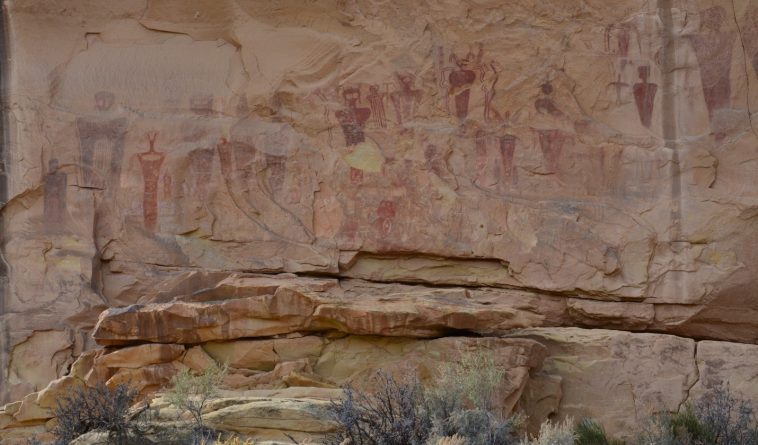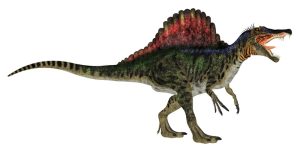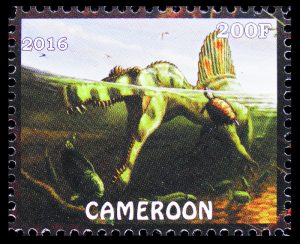The desert southwest of the United States contains numerous paintings and other rock art. Some demonstrate that Native Americans saw dinosaurs. In Utah, there are petroglyphs of penguins. Neither fit in well with theories of deep time. Both are, however, consistent with biblical creation and the global flood.
“If you want to see some spooky petrographs, check out Sego Canyon.”
That’s the advice a friend’s cousin gave when we wanted to know if he knew where any Native American images of dinosaurs were.
If you leave Interstate 70 and head north through the almost-ghost-town of Thompson Springs, Utah, then follow the dirt road for four miles, you come to something astounding. At the Sego Canyon picnic area, there is a thirty-foot high by one hundred foot long sandstone cliff covered with paintings and carvings made by artists over the centuries.

Across Sego canyon on the eastern wall, we saw our first dinosaur depiction:

Painted between two anthropomorphs is the first dinosaur we recognized from Sego Canyon: a hadrosaur, or duck-billed dinosaur. This is a Parasaurolophus hadrosaur dinosaur, painted in about 1,000 AD by Native Americans.
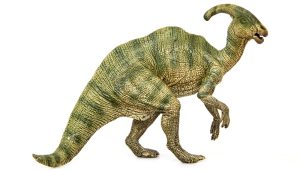 It has the right head, neck, placement of the eye, and size of body. The front legs are shorter and smaller than the rear legs, just as Parasaurolophus has. It has the curved head crest, and the bony extension above the lips. The whip-like tail was the first thing that caught our eyes, and it is the right thickness, though it is longer than the re-creations show.
It has the right head, neck, placement of the eye, and size of body. The front legs are shorter and smaller than the rear legs, just as Parasaurolophus has. It has the curved head crest, and the bony extension above the lips. The whip-like tail was the first thing that caught our eyes, and it is the right thickness, though it is longer than the re-creations show.
But the surprises continued.
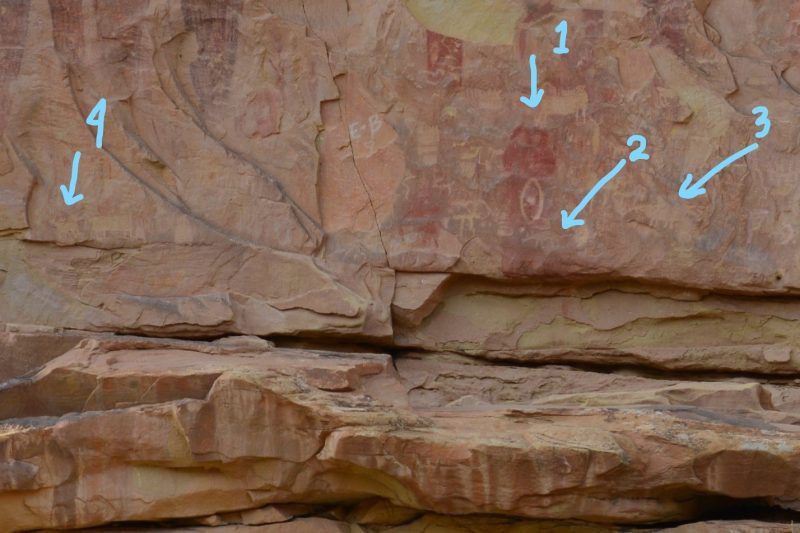
Chipped into the rock, through the red paint of (1) Dino’s neck, is another small image – with spikes above and below the neck (2); it is similar to an Animantarx dinosaur.
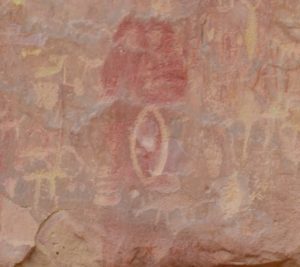
To the right, there is yet another dinosaur; this one (3) is a Spinosaurus, with a sail on the back, webbed feet, long tail, and an enormous head. This is the only known species of swimming dinosaur.
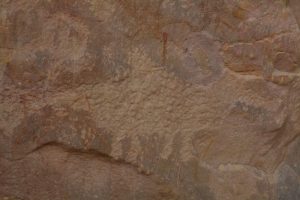
Notably, on the head of the Sego Canyon Spinosaurus, the eye and possibly a nostril are on a smooth surface of rock. This smooth upper face may indicate that Spinosaurus, like alligators, lay submerged while in wait for its prey.
The fourth dinosaur in this photo is to the left, past a square bighorn sheep.

This (4) is a Dracorex dinosaur, whose only skull found so far is in the Children’s Museum in Indianapolis, Indiana. And it does not end there. The Dracorex got its name because it looks like a dragon, but is a dinosaur. The Dracorex image is chipped into the rock, through an older red-or-purple painted image. The purple image has a large body and long tail to the left, one leg which was not chipped away, and a neck that curls over the shoulder.
This image even has an open mouth. It may be another sauropod dinosaur. If so, there are five dinosaur images made by Native Americans on this small area of the main panel at Sego Canyon.
Note that in the photograph above, the 1884 graffiti has not faded much, while the Native American images have faded. This is one of the clues used by professionals to estimate the age of the images. They are clearly hundreds of years, perhaps a thousand years, older than the graffiti. The chipped images are chipped through the painted images, so they are more recent yet.
Next came what was our greatest surprise in Sego canyon
In the horned and helmeted man, at the base of the painted image, there is a chipped image, outlined in cobalt-blue dots. These were the first cobalt-blue dots that we were aware of Native Americans using.
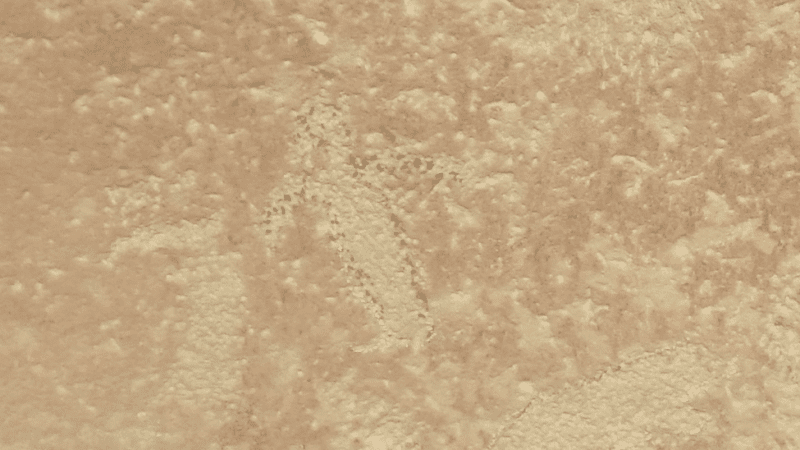
This chipped image is of a penguin.
Here is a penguin image, in eastern Utah, USA, done in about 600 to 1,250 A.D. by an artist from the Fremont peoples. And this is not simply a penguin; the body shape, the proportions of the head, the length and width of the flippers, even the leg length and the shape and size of the feet match one species of penguin – the Galapagos Penguin. It even has a black stripe going up the face, as some Galapagos Penguins have. And the cobalt-blue dots are an excellent way to show that this white-fronted bird has a black back.
And the head of this penguin has a feature I have never heard of for a petroglyph. All three of us saw that the head has an optical quality that makes it appear to pop out of the wall. Although it is a flat image on a flat sandstone wall, the head appears to pop out, three inches from the wall. Although I am an engineer, the artist had more knowledge of optical physics than I have! About half the people we have shown this image to have seen this effect.
If this were the only penguin image here, some might shrug it off as creative imagination. But, next to it on the right, after a bear, are four other penguins, done in varied skill.
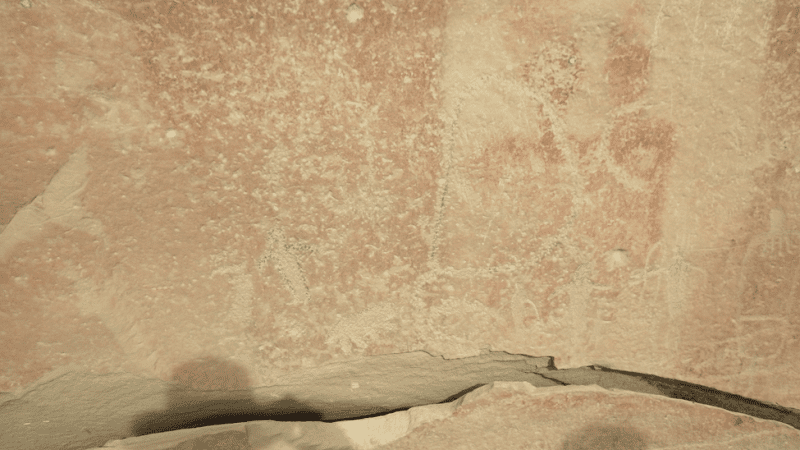
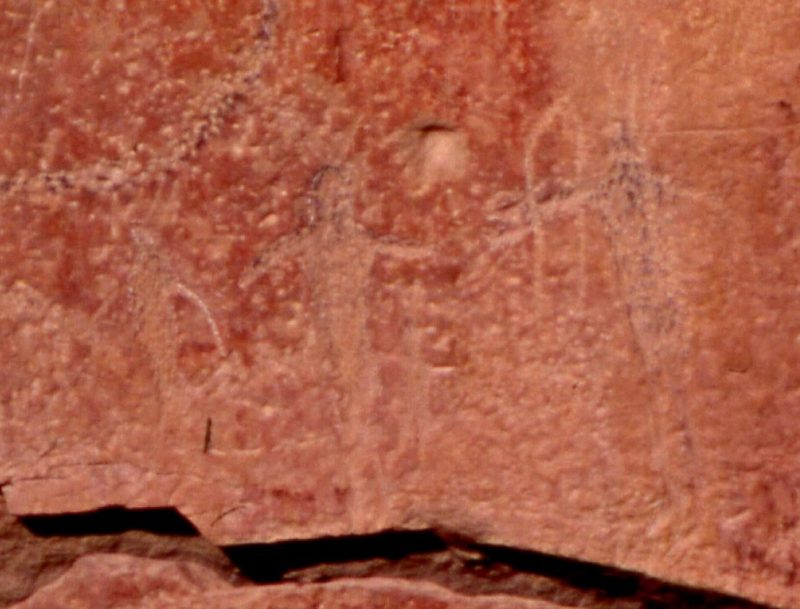
Penguins and dinosaurs in eastern Utah, any time after men had arrived to paint or etch their images, are major contradictions of secular history.
How could penguins have been in eastern Utah, USA?
When Noah and his family let the animals off the ark, some of the people may have kept penguins as livestock. They are useful for eggs, meat, and especially their warm feathers and skins; all were needed during the cold and wet conditions after the flood. In the dispersal from the Tower of Babel, some people groups took their livestock with them, and this may have included penguins.
When men with penguins arrived in Utah, they found Grand Lake. Grand Lake was a pluvial (Ice Age) lake created by an earthen dam, located and described by Dr. Steven Austin and Dr. Tom Brown, in northern Arizona. The lake covered 30,000 square miles (Austin, Grand Canyon, Monument to Catastrophe, 1994, page 93; Brown, In The Beginning, 2008, pages 129; Figure 106), including some of Arizona and Colorado, plus most of eastern Utah, and extended past Sego Canyon into the Grand Junction area of Colorado. The northern lake shore was just 500 yards south of the Sego Canyon petroglyphs. Grand Lake provided an excellent environment for the penguins – and for the swimming Spinosaurus dinosaur.
And what was their destiny? When Grand Lake breeched the earthen dam, the massive flood swept through Arizona and Utah, carving Monument Valley, carving out Grand Canyon, and sweeping on to the Gulf of California. This is known to secular geologists as the Great Denudation, which removed thousands of feet of earth over a vast area, leaving flat plains between the cliffs of the Grand Staircase.
This is also known in the oral history of the Havasupai people who live in Grand Canyon, west of the national park. The Havasupai, Navajo, and Hualapai all have historical memories of Grand Canyon being formed after a global flood.
As a result of losing the weight of water and earth, the Kaibab Plateau rose dramatically, so Grand Canyon has rims thousands of feet above where they were before the dam breeched. The flood swept along the penguins, but those in the upper reaches near Sego Canyon were in smoother water, so they survived the trip. When they were dumped into the Pacific Ocean past the tip of Baha California, they needed land for raising their chicks.
The Galapagos Islands were 1,853 miles southeast, which is an easy swimming distance for penguins. This may explain why Galapagos Penguins are the only penguins north of the equator. The closest other penguin breeding area is another 800 miles southeast, where the similar Humboldt Penguin lives.

